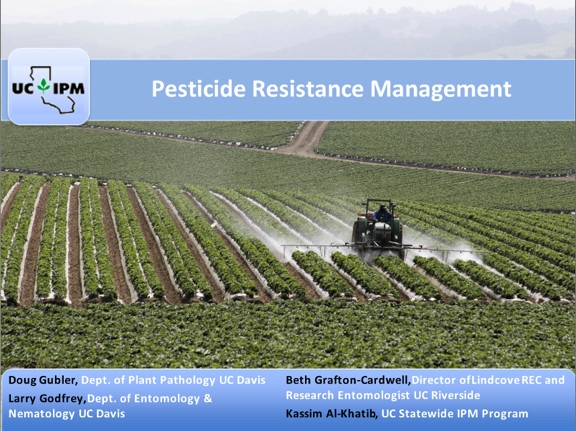
When a pesticide is applied, some individual insects or weeds are killed and others are not. The individuals that are not killed vary genetically from the ones that were killed, and when they reproduce, their offspring are also likely not to be susceptible to the pesticide. Over time, the population changes and you are left with the genetically resistant individuals as the majority of the population. Resistant pests can result in higher pesticide rates being applied and more frequent applications. We see resistance occurring in weeds, insects and pathogens.
Pest control advisers and growers are often the first to see what is going on in the field. After a pesticide is applied, they may be the first to report back to researchers if the application was effective or not. If they see patterns of decreased susceptibility of a pest population to a pesticide that was previously effective at controlling the pest, they may conclude that resistance is occurring. Pesticide resistance is the topic of a new online course developed by UC IPM that can help PCAs and other licensed pesticide applicators recognize resistance when it is occurring, discover how it developed, apply practical methods of managing it and delay its occurrence.
The new online course covers resistance within the disciplines of plant pathology, entomology and weed science. It is based on a series of workshops on resistance management held in Davis, Fresno and at the UC Kearney Agricultural Research and Extension Center during the spring of 2014 presented by UC Cooperative Extension specialists Doug Gubler (Dept. of Plant Pathology, UC Davis.), Larry Godfrey (Dept. of Entomology and Nematology, UC Davis), Beth Grafton-Cardwell (Lindcove Research and Extension Center and UC Riverside Dept. of Entomology), and Kassim Al-Khatib (UC Statewide IPM Program).
There are several mechanisms through which pests become resistant to pesticides. One mechanism common to all three disciplines is target site alteration, where the site a pesticide normally attacks is somehow altered and no longer allows a pesticide to bind and affect the pest. Metabolic resistance is another mechanism, where pests detoxify or break down the chemical before it can work.
Although some differences occur in delaying or managing resistance across the disciplines, the key is to try to avoid intensive applications of pesticides so as not to allow resistant pests to become the majority of the population. Good IPM practices can reduce the need for pesticide applications. Rotating chemicals with different modes of action can also help manage resistance.
For an in-depth look at pesticide resistance, check out the new course at http://www.ipm.ucanr.edu/training/pesticide_resistance.html. This course has been approved for two continuing education units in the “Other” category from the Department of Pesticide Regulation.